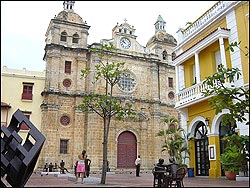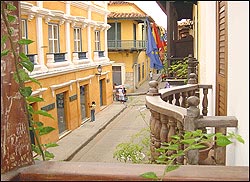 |
Wish
U Were Here Losing My Religion Church-going and club-hopping in Cartagena, Colombia |
by Grace Bastidas August 11th, 2005 5:00 PM After a few visits to Cartagena, Colombia, I once told my family I wanted to quit my job, move to the Caribbean city, and sell braided bracelets on the beach. I imagined a perfect existence in which my schedule (or lack thereof) would consist of chatting up tourists while lackadaisically hawking my wares; eating fried fish at an oceanfront restaurant for dinner; and then heading to a party, which would definitely involve aguardiente (a potent sugar-cane liquor) and table-dancing with friends. |
 The exterior of Iglesia y Convento de San Pedro Claver photo: Grace Bastidas |
Cartagena is like a vacation fling that inspires you to ask "what if" even though you inevitably have to go home and be back at work on Monday. It's by far Colombia's biggest tourist destination. I've met folks from Italy, Canada, Guatemala, and many other countries there. Some go for the International Film Festival that takes place every June; others flock to ogle some of the prettiest women in the world at the Miss Colombia pageant in November; and still others make the trip because, well, why not? Last time I visited, I invited along my 22-year old cousin who lives in Barranquilla, a neighboring city about an hour and a half away by car, for a weekend retreat. We stayed at La Casa del Arzobispado, a hotel in what is called "the old walled city" (a part of town surrounded by a stone fortress built during the Spanish occupation to keep pirates out). This area is a testament to 16th and 17th century architecture. As we strolled along the cobblestone streets and below the overhanging balconies of El Centro, we found ornate churches, colonial mansions, and large plazas—each street seemed like a postcard onto itself. |
|
Even
our hotel, a grand house originally constructed in the late 1500s, harkened
back to another time. Hidden behind a big wooden door adorned with a
brass doorknocker, La Casa del Arzobispado is a small boutique property
with only ten rooms, including a presidential suite. Not surprisingly,
religious motifs decorate the walls along the corridors—this was
after all the house of the archbishop at one point in history—creating
a peaceful escape from the busy streets, which coincidentally boast
a church on every couple of blocks.
It's obvious Colombia, a mostly Catholic country, loves religion. The nation averages around 11 religious holidays a year, making three-day weekends a perfect excuse to head to the beach. Easter is one of the busiest times for this coastal city, as natives arrive in droves and not necessarily to tour any churches. |
My cousin and I felt obliged to pay a visit to the lord before engaging in any sort of debauchery. The majestic Iglesia y Convento de San Pedro Claver, which was constructed in the 17th century and is an imposing three-story structure, is perhaps one of the most beautiful. It was founded by the Jesuits and named after Pedro Claver (1580-1654), the "Apostle of the Blacks"—he spent a lifetime ministering to slaves brought from Africa (70 percent of the population is Afro-Colombian). As we wandered the grounds, amidst toucans and macaws, we felt anointed of any sins. That "clean slate" feeling didn't last very long though. Cartagena's beaches, restaurants, and nightlife are enough temptation to lure even devout Catholics (or a couple of girls like us) out to play. The most popular beaches are located in nearby Bocagrande and El Laguito and are flanked by hotels, restaurants, fruit stands, and shops. You can rent chairs under a tented area and sit back as women try to braid your hair, sell you a medley of tropical fruits, or offer you a foot massage—it's one-stop shopping from the comfort of your patch of sand. Often, guys who rent chairs will also sell fresh seafood cocktails and cold beers. You can't beat this type of service. The best beaches, though, are found in Islas del Rosario, an archipelago of about 25 small coral islands about two hours away from Cartagena by boat. The sea around the area varies from turquoise to jade and hosts an amazing array of marine life, making this a great destination for snorkeling and scuba diving. Though I normally like to sign up for all sorts of activities, I opted to sit back and relax on Playa Blanca in the island of Baru. This stretch of white sand and crystal water is perfect for sunbathing and scheming for the night ahead. |
Luckily, my cousin and I have similar points of view and were able to agree that the end of the day means it's time to eat, drink, and dance (feel free to reorder that sequence for your own purposes). We indulged in fresh seafood at La Casa de Socorro, a home-style restaurant where, before it's cooked, you choose your red snapper—or any other available type—from a tray displaying three whole fishes. The final dish, a local favorite, includes coconut rice, fried plantains, and a salad. Since I was treating I was happy to see the bill total less then $25—a moderate price by Colombian standards. |
 An apple a day: Fruit vendors take a break photo: Grace Bastidas |
After heading back to the hotel for a quick shower and an outfit change, we made our way to Café del Mar, Colombia's version of the Ibiza chill music bar. Located on a fort overlooking the ocean and the city, this outdoor watering hole is where all scenesters gather for cocktails before they're beckoned elsewhere. After a few New York-priced caipirinhas we knew we had to move on. Mr. Babilla, located on a strip of bars and nightclubs near the city's Convention Center, may be one of the oldest clubs in Cartagena but it still ranks as one of my favorites for dancing. So what if tour groups usually drop their guests off here? No worries, it makes for interesting conversations since natives and tourists tend to equal out. (Plus, my cousin got to practice her German with a cute guy from Munich.) The real draw, though, is the table dancing that ensues after a couple of busty female bartenders dressed in tight jeans and midriffs jump on the bar to move to all sorts of rhythms—if there is a cheese factor to Mr. Babbilla it's immediately forgiven after their routine. Ask any man. A night here can go till 4 a.m. as it did for us. Since Cartagena is the type of all-inclusive vacation that makes visitors beg for seconds, we inevitably repeated the same program the following evening. I'll spare you the details. Apart from all the history, culture, and romance the city has to offer, it's evident there's always plenty of carousing to be had. Plus, the accessibility of all the churches means you can always repent at a church nearby before heading back home. That's the beauty of Catholicism—almost all is forgiven. |
| The Village Voice |
